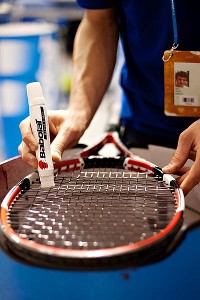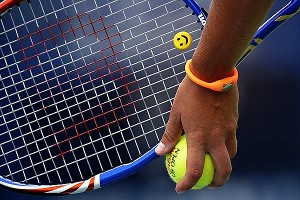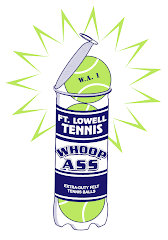The problem most players have when it comes to the mental side of doubles is that they don't actually know how and where to get started.
And if you can't start you certainly will not finish.
Players lack the tools to help them overcome the various hurdles that pop up in a match and to propel them to achieve exactly what their doubles skills deserve -- winning.
Here are six tools to help put you in that mentally tough place that makes winning a heck of a lot easier -- and losing a very difficult option.
Maintain Perspective
Once you get onto the court (if not before), you and your partner need to start working together for the one cause -- to win the match.
The best way to do that is for both of you to get your heads into the match as soon as possible and keep them there for its duration. That means that all of your thoughts are centred entirely on the match and ignore anything else that will only cause a distraction.
When I talk about maintaining perspective, I mean that you have to keep yourselves in the present and in the now if you want to maximize your performance and minimize interference from any mental hurdles that may arise.
This means that any dialogue between the two of you (and to yourselves in your head) must strictly be about what is happening right now in the match because it is the only thing you can control.
You must avoid talking about the things (both good and bad) you both cannot control, such as the past. Avoid statements like "I can't believe how bad I was in the last service game," or even, "How good was the drop shot I just played?"
The same holds true for future events, such as, "What can we do to make sure I hold my serve next time around?"
Your concentration must be fully focused on what is happening now, which means the next point and nothing else is all you can control.
Execute Your Game Plan
This is an element that, believe me, 99% of the players I see out there are not using.
Forming and then executing a game plan is one of the most important things you can get into the habit of doing as a tennis competitor.
First off, because hardly any one else does it, and, secondly, because it gets you going into the match with a very clear (mental) plan about what you and your partner need to do.
When I was playing my best doubles, we never went into any match without some kind of prearranged plan about what we were doing.
Game plans come in two basic forms:
1. As a result of what you have scouted from watching your opponents or know about them previously.
2. You haven't seen your opponents, but you formulate a game plan based on your own game and what you want to do in the match.
 Option one is the more powerful of the two because you can discuss specific tactics regarding the upcoming match, but please do not overlook option two.
Option one is the more powerful of the two because you can discuss specific tactics regarding the upcoming match, but please do not overlook option two.In many ways this is the most important option because it forces you to come up with a plan to try and play the game how you want it played -- and this is very important. Too many doubles pairs spend too long worrying about what their opponents are doing and ignore their own game.
Think about your own strengths and weaknesses and come up with ways to maximize those strengths -- and avoid the weaknesses -- all in the context of what you know (or find out during the match) about your opponents.
This will allow you to go into a match armed with a mental map of how to find the treasure (the win), and lets face it, you are much more likely to find the buried treasure if you have a map instead of hunting around the island with absolutely no clue where to go.
Your mental strength increases with the clarity that having a map/game plan brings to the table, which is way beyond what most other doubles teams do in preparation for a match.
Never Play Your Opponents
One of the biggest failings I see in many teams is the handing out of disproportionate levels of respect to opponents. I see it all the time.
In reality, you are not playing your opponents when you are playing a tennis match, you are playing the ball!
First and foremost, you have to react to where the ball is going, what the ball is doing and what you are doing to the ball before you worry about your opponents.
When you are playing a highly ranked pair, you need to respect their standing, but not so much that it stops you from playing to win. See this as an opportunity to go out and play as hard as you can.
View it as a chance to put together everything you've been working on and see how it matches up. Even if you end up losing, the next time you play a similar rated/ranked pair you will be that much stronger for the experience.
When you are playing a lowly ranked pair, this is another great chance to move your game on.
Try to use this opportunity to try out some of the things you have been trying to introduce to your game. Implementing new tactics during a match is always more beneficial than doing it in practice -- and there won't be as much pressure in a situation like this, so you can play with more freedom.
Toughness Through Practice
You don't just wake up one day mentally tough!
Mental toughness is something that needs to be learned and honed regularly. It is a skill like most other skills that is susceptible to the training law of reversibility -- you either use it or you lose it!
So you need to place yourself in pressure situations on a regular basis. You need to know what it's like to be in a tight match and lose as well as win. You need to have come back when you were well behind. You also need to lose when you were well ahead.
These experiences will make you stronger and will also give you the edge over those that haven't experienced the things you have.
It's not quite like practicing a forehand, which you can to a certain extent just hit 10,000 balls to improve and groove the motor response, mental toughness comes from the practice of being, well, mentally tough.
So, seek out as many opportunities to challenge yourselves mentally as you can. You will learn a lot about yourselves and your coping mechanisms as well as giving you the much-needed practice that will be needed when it matters the most.
Practice Tip - incorporate pressure into your practice i.e. play a set where you as a team only have one serve on service games or start each game 30-0 down etc.
Attack with attitude
Attacking with attitude means that your thought process is all about playing for the win (within the rules, of course) and never playing to avoid losing -- big difference!
It's about understanding that there is nothing wrong with a scrappy win, and that you even if you do lose, that you take something from the experience to make you stronger.
It's about both of you displaying this attitude from the first ball and making it obvious to the other team that you will be playing hard all the way to the last ball (however long that takes).
It's about targeting a weaker opponent if you see that one player of the opposition is more fragile than the other.
It's about not being afraid to visibly step into the court to receive serve when you see your opponent struggling with their second serve.
It's about not being afraid to show a positive emotion if you win a point from a net cord (even though you hold your hand up), rather than being so apologetic that you are guaranteed to lose the next point.
These are some of the traits of winners -- so use them.
Lose Your Fear of Losing and Winning
One of the biggest downfalls I see in doubles teams, and tennis players in general, is the fear of both losing and winning.
Most players don't really understand the differences, and as such, they don't know what to do to avoid them. So let's change that.
Fear of losing tends to occur in situations where you are supposed to win -- like when playing a pair with a lower rating or ranking. You get so wrapped up in worrying about what people will say if you lose this match that the freedom you would normally play with and the freedom needed to play well is strangled along with your game.
Fear of winning can happen when you find yourself in a winning position against a pair ranked or rated higher than you. You somehow don't believe that you can or should win the match because this team are better.
In both situations, you find that confidence and self doubt become an issue -- and we all know that playing with confidence issues makes winning very difficult.
Don't allow yourself to think about winning and losing (an outcome) and only worry about how and why you will play the next point (the process).
Constantly talk to each other about your game plan and your jobs on the court and never talk to each other about the outcome.
Discussing the ball and what you are going to do with it will stop you from drifting towards the end of the match, which will naturally lead you to start thinking about winning or losing and will cause you to drown quicker than you can spell "choke."












